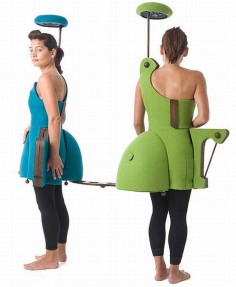DI MAINSTONE
sharewear
source: dimainstone
Artist and researcher, Di Mainstone creates body-centric sculptures, designed to initiate movement and storytelling. Many of these wearable artefacts are inspired by technology. Some of them release sound when handled. Often, they can be modified to create new silhouettes, environments and functionalities. All of them tell a story.
Di’s body-centric devices have been performed at home and abroad, most notably at The V&A, The Barbican, The National Portrait Gallery, Eyebeam NYC and the Swedish National Touring Theatre. Each happening is unique, revealing openings for audience and performer encounters. Di’s work can also be seen in films, which she writes and directs.
Di’s studio is found up a windy stairway, amidst the reclaimed tube trains that roost on top of Shoreditch’s Village Underground. Here her sculptural adornments are brought to life with dancers and musicians. As Artist in Residence at Queen Mary University, Di collaborates with Scientists to incorporate new technology into her body-centric creations.
.
.
.
.
.
.
.
source: v2nl
Distorting the seam between home comfort and urban exposure, SHAREWEAR creates an in-between place amid private and shared space. The work comprises of a pair of reconfigurable, electronic dresses that physically slot together to activate atmospheric pools of light. Unleashing potential for intimate chance discoveries, they are worn as part of a performance, inviting both wearer and audience to get close, lean on one another, morph space, manipulate light and cast long shadows.
Dress 1 is constructed from interlocking slats of high-density foam, later encased in thick woollen upholstery fabric. Both dresses incorporate especially designed wooden elements used functionally as a means of support or connection. The dress takes influence from abstracted modernist furniture design, more specifically iconic symbols related to the home, such as reassuring beams of light and fabric covered buttons found on our most comfortable sofa. Dress1 can link to its twin in several ways. The garments are united by strong magnets which trigger pools of light, used in the performance to cast shadows. The light sources are hidden in a hovering hat and a compartment in the skirt of the dress, which can be lengthened or shortened by pulling a lever.
Built from modular slats of high-density foam and enclosed in thick woollen upholstery fabric often used for modernist furniture design, Dress2 can unite with its twin in several ways. The two can slot together like a jigsaw to trigger dramatic shards of light, used in the performance to cast shadows. One of the light sources comes from a hovering hat, which is suspended above the dress leaning from a reconfigurable pole, which sashays architecturally off the shoulder and the other comes from a hidden compartment in the skirt of the dress which allows the wearer to play with the shape and pattern of the light.
Share
Having been assembled live SHAREWEAR dresses are then able to join, reconfigure and illuminate in a multitude of ways. Not only can the wearers manipulate the dresses themselves, but audience members are also invited to unveil a series of potential narratives. Through this act of sharing the dresses reveal hidden secrets. They link to activate light and divulge new landscapes. Playful wooden modules can migrate from one dress to the next to define the mood and ambience of the light patterns. The light can be positioned to emphasize the body or to cast long shadows on the wall.
Wear
SHAREWEAR dresses are exhibited through performance, which simultaneously merges the line between performer and audience. Constructed from a series of magnetic modular blocks, the audience witnesses the work being unpacked from 2 flat-pack crates and assembled in real-time. Both wearer and audience are able to be part of this playful construction process by slotting the modular forms around the human form to create their own structure. British sound artist and producer Scanner composed a playful soundscape, which is used throughout the presentation, to delineate hidden narratives and encourage the flow between audience and performer.
.
.
.
.
.
.
.
source: designdautoreblogspot
Il primo è il progetto SHAREWEAR, una collaborazione investigativa di moda e tecnologia che coinvolge Di Mainstone and V2_, Institute for the Unstable Media. L’idea base parte dal rapporto tra la qualità di vita nell’ambiente urbano ed il confort offerto dall’ambiente domestico: SHAREWEAR crea un luogo intermedio che coniuga, in maniera teatrale e ironica, spazio privato e spazio condiviso.
.
.
.
.
.
.
.
source: awarenesslabnl
Wearables zijn kledingstukken of accessoires die zijn verrijkt met elektronica. Hierdoor krijgen ze extra functionaliteit en worden intelligent of interactief.


